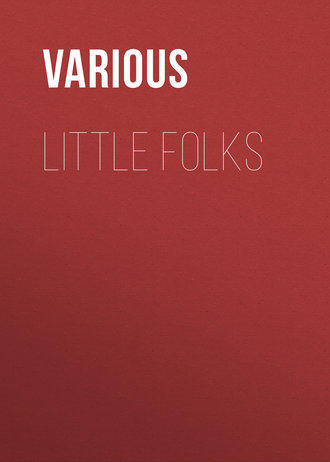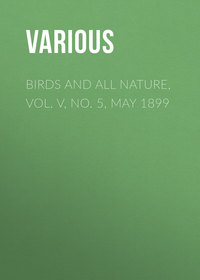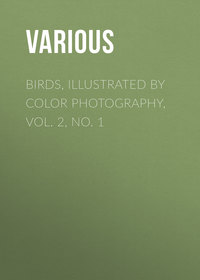 полная версия
полная версияПолная версия
Little Folks
To stretch it, we must proceed in the following manner. Lay the canvas evenly on the frame and nail it over the back; when all four sides are thus secured, take the wedges, and hammer them into the holes made purposely for them until the canvas is sufficiently stretched. Be careful to place the board in a good light for painting; it takes much longer to do, and cannot be done half as well either, if the worker sits so that the shadow of her hand falls on the picture. A piece of clean writing-paper to place at times under the hand to prevent finger-marks may be found useful.
Now for the painting. We will begin with the face. In colouring photographs, the paints have to be constantly washed off, and it is a well-known fact that nothing does this so well as the tongue, because it acts on the photo so as to remove all grease better than anything else will: but some people will perhaps be somewhat afraid thus to wet the surface, on account of the nature of the paints. The tongue may, however, be used at any rate for the flesh parts, and a small wet sponge can be employed for the rest of the picture. Wet the complexion over with the tongue, then wash in the shadows with some flesh shadow mixture, to which a little canvasine medium and water have been added, and wipe it off again at once. Pay attention to the shadows that they are of the right tints: for fair children they will be of a slightly blue hue; for dark complexions a little wood brown must be added to the shadow colour. Now lay over the complexion a wash of flesh-tint No. 1, and wipe it off again directly; repeat the wash as often as necessary until a good colour is obtained. Sometimes as many as six applications are needed; the great point is to get a good even layer of colour. In rendering dark complexions, a trifle of wood brown may be added to flesh No. 2, and this will give the requisite depth of colour. Put in the warm complexion-tints with flesh No. 2. Place a drop of it, modified with No. 1, over the whole cheek, and wipe it off again immediately. Repeat until the right strength of colour is secured; deepen the tint as it nears the centre of the cheek, so as to preserve the rounded appearance that is one of the greatest charms that youth and beauty possess. Strengthen the shadows under eyes and eyebrows, round the nostrils, and on the chin.
Mixtures of blue and brown, and of green and brown, serve for the demi-tints which soften the deep shadows by gentle gradations into the local colouring. The tints may be effectually blended into one another by an occasional wash of flesh No. 1 being carried over the whole.
Between each operation the colour must be dabbed off as soon as it has had time to sink into the photograph; it must not in any case be allowed to rest long, or the wash will dry spotty, and when that happens it is exceedingly difficult to remedy. The draperies are washed in before the details of the face are begun, as when the latter are painted the colours must not be wiped off afterwards; they are not treated in the same way as the washes, but more as finishing-touches.
Draperies and backgrounds are laid in with a full brush in broad washes, the photograph being first damped slightly with canvasine medium; the colours are laid on freely with decisive strokes, and sponged off, the washes being continued until the tint is dark enough. Skies may be represented with blue tinged with green, and when dry, some light clouds may be dabbled in with Chinese white.
Now we return to the face. With flesh No. 2 touch in the lips carefully, and shade the tint off gently, for they must on no account look hard; also mark in the nostrils with a little of the same, but now the colour must not be washed off. For the eyes, use blue, brown, or grey, as requisite; grey is composed of a mixture of blue and brown. The pupil of the eye is put in with black, and the light with a touch of Chinese white. In the corner of the eye a trifle of flesh No. 2 will be needed. The eyebrows should be rather darker in colour than the hair, but they must not be too heavily painted; the best plan is to wash them in with a lighter tint first, working them up afterwards with a fine brush and almost dry colour of a darker shade. The eyelashes, too, must be washed in along the eyelid, and then a few hairs marked out with the point of the brush. It would never do to put them in entirely in thin fine strokes, for they would be sure to look hard. A little blue added to brown will make a tint dark enough for most purposes, and the use of black should be avoided whenever possible.
The hair will need our next consideration. For fair hair, golden brown must be employed; it is applied in washes, wiped off as before, and repeated until the desired depth of local colouring is obtained; the shadows are worked in with light brown, the lights with a little Chinese white. For dark hair, use wood-brown and sienna; and the darkest hair may be rendered with washes of blue, which must be applied before the sienna, with Chinese white used freely for the lights. Colour which has once been allowed to sink in cannot be removed, therefore we must be careful not to use a wrong one, or even too dark a shade. Then, again, colours dry darker than they appear when first laid on, so we must take the precaution to make our washes lighter than we intend them to be when finished.
Beautiful tints can be produced by the admixture of the colours, and charming effects by the juxtaposition of colours that form an agreeable contrast.
A RACE ON THE SANDS
One cool and pleasant afternoon,Before the sun was set,A fox and other country folkUpon the beach had met.The creeping tide far out had ebb'd,And by the shelving strandThere stretch'd a wide and level plainOf glist'ning yellow sand.The hare, the hound, the neighing steed,The lowing ox, the deer,The sheep, the hog, the braying ass,The sea-gulls hovering near,With groups of various birds and beasts,Of sorts both tall and scrimp,Were gather'd there upon the sands;And thither came a shrimp.Now Reynard, who was eager bentUpon some cunning wile,Did boldly challenge any beastTo race with him a mile.But when nor horse, nor hare, nor houndHis challenge would receive,Up started Shrimp, and cried, "Good sir,To race you give me leave."A burst of merriment then brakeFrom all the beasts around,The westward-sinking sun did smile,Though he utter'd not a sound.Then out spoke Reynard, red with rage,"Thou mak'st a mocking boast!"But near him whisper'd Master Hare,"Forget not how I lost."The race anon was quickly plann'd,Eftsoons a judge was nam'd,And Fox and Shrimp quite ready stood,Though Shrimp seem'd half-asham'd.And now they start, one, two, away!See, Reynard darts ahead,Unconscious that sly Shrimp had jump'dUpon his tail outspread.There snug he lay, so close and warm,While Reynard tore apace,And laugh'd, as only shrimps can laugh,In his comfortable place.At length, as Reynard near'd the goal,He slowly slacken'd speed,And stopping, ere he touch'd the post,He turn'd—he did indeed.Then off hopp'd Shrimp, and stood at onceUp at the winning-place;While Reynard still look'd back and cried,"How now, who wins the race!Where are you, villain? where are you?Not e'en in sight, I trow!""Nay, pardon, sir," behind him criedThat sly Shrimp with a bow.Then Reynard, all abash'd, did stareTo find himself outdone!While the jeering crowd, in high delight,Went wild at all the fun.But Reynard could not bear their gibes:He slunk in haste away;Nor ever guess'd how Shrimp contriv'dTo win the race that day.THE KING AND QUEEN'S QUARREL
(NARRATED BY A DOLL)
I was very pleased indeed, when I first came into the world, to find that I was to become the property of a King and Queen. I had seen a great deal of life through my shop-window, and had come to the conclusion that I was formed for high society. So therefore, when my new mistress said to me, "Dolly, I am the Queen to-day, and Bertie is the King," I was not at all surprised, but held myself as firmly as before.
The King and Queen sat together on one chair, which I suppose is the constant habit of Kings and Queens. They were both very nice and neat, for the nurse had just brushed their hair. The Queen was four years old, and the King was six. And they were both the very prettiest children you could see.
The little Queen had a blue print frock, and a little round face. She had pretty shy eyes that looked out from beneath a shock of curly hair. The little King was very pretty too. And he liked to play with dolls, which I always think is a nice trait of character in a boy.
"Oh, what a lovely doll!" cried the Queen, when she first saw me. I may repeat it without vanity, for I suppose it was true. Anyway it is exactly what everybody said the moment they set eyes on me. People always praise dolls to their faces, and that is what makes us look so conceited. Even when we are old, and battered, and worn-out we still preserve a somewhat conceited air—we still look pleased and proud of ourselves so long as there is one little child who loves us, and who thinks us pretty still.
The King and Queen sat down together on their throne, and were as happy as happy could be. The little Queen's feet dangled a good way off the ground, but she did not mind that in the least. She put one chubby arm round her brother to keep her quite firm, and the other arm was round me.
When a nice little fat, dimpled arm holds me tightly against a loving heart, I feel very pleased and happy. If I were a pussy-cat I should purr, for I feel that I am in my right place.
"Now I am King and you are Queen," said the little boy; "and everybody that comes in must bow to us."
"Dolly shall be the Princess," said the little girl, in a voice like that of a cooing dove.
"Her name must be Sophonisba," said the little boy gravely. "That sounds something like a Princess."
"Topanithba," repeated the little girl, very much pleased; and she pressed me close to her heart.
Suddenly a cloud passed over the face of the little boy. He looked at me hard for a minute, and then he spoke.
"No, that won't do at all," he said; "I am an old French King, and we're under the old Salic law. She mustn't be a Princess, or she'll never come to the throne. We must pretend she is a Prince, and we'll call her Jack."
You should have seen the little girl's face at this. All the dimples went out of it, and she looked quite frightened.
"Oh, don't call her Jack, dear," she cried; "it's so ugly. And I'd rather she was a Princess."
"Then she'll never come to the throne," said the boy solemnly. "I read it lately in my history."
Here the little girl looked much inclined to cry.
"Oh, don't say she won't come to the throne!" she cried piteously. "I like my Princess Sophonisba so much."
"She'll never come to the throne," said the King, laying down the law with his fore-finger; "a Princess is no good at all. She's a stupid."
"Well, she shan't be called Jack," said the Queen, plucking up a little spirit.
"Then I shan't play," said the little King, at once jumping down off the chair.
The little Queen put her finger in her mouth, and looked as if she did not quite know what to do. She did not care to play without Bertie, but she wanted to have her own way. She glanced at Bertie out of the corner of her eye. He turned his back to her directly, and would not look her in the face. Yes, there was no doubt about it—she could tell it from the look of his shoulders—Bertie was in the sulks.
All their play was spoilt. The throne was deserted, the sceptre laid down. They did not care to be King or Queen by themselves.
"I shall go down to mamma, then," said the Queen, and she put me down on the chair, and went off.
For some time Bertie stood in the corner, looking very cross. Then he looked round, and began wondering when May would come back. Next he commenced to cry.
"Naughty girl! naughty girl! I don't want her to come back!" and he took a piece of string out of his pocket, and kept slashing it against his sleeve as he spoke.
Suddenly, in the midst of his temper, he caught sight of me.
"Nasty doll!" he cried; "we should never have quarrelled if it hadn't been for you! You shall be a boy," he added, sternly; "for I'll cut all your hair off!"
A shudder went through me. Unfortunately the nursery scissors were lying on the table—he took them up, and in a minute it was done. Clip, clip, went the scissors, as if they were pleased, and nearly the whole of my flaxen curls lay scattered on the floor. How I looked I don't know, but I think Bertie was a little frightened when he saw what he had done. I don't think he was anxious for his sister to see me, so he jumped up on the fender and put me on top of the mantel-piece.
Here I lay, with my feet dangling down off the side, about as uncomfortable as a doll could be. Nearly all my hair was cut short, my hat had fallen off in the fray, and I found myself in a position of much discomfort, and even danger. I could see nothing that went on in the room, and the heat of the stove was fast melting my beautiful complexion. I tried to look like a Princess, but it was hard.
The nursery-door opened, and the little girl came back. In a minute she ran up to the chair where she had left me, and then looked at her brother.
"Where's dolly?" she cried, and she looked anxiously round.
"I shan't tell you," said Bertie, beginning to look frightened.
"Oh, dolly, dolly; where is my dolly?" cried the little girl, and how I longed for a voice that could answer her. I could hear her going all round the room, pulling open drawers and cupboards, and hunting for me, but I never said a word.
Suddenly I heard a cry. She had come to the hearth-rug, where lay the scissors, and nearly all my beautiful flaxen curls on the floor.
"Oh, my dear dolly! my dear dolly! He's cut off her hair. Oh, you cruel boy!" cried the little Queen, and she sat down and cried as if her heart would break. Then she glanced up, and caught sight of where I lay, placidly reposing on the mantel-piece with my eyes turned up to the ceiling. In a moment she was upon a chair, and ready to fetch me down, when what with the chair being unsteady, and her eyes being full of tears, the chair slipped beneath her, and down she fell on the floor.
Poor little Queen, she was in a very bad way! Her head fell against the fender, and hurt her very much, she sobbed and cried both with the fright and the pain. Nurse came running up, and took her on her knee, and it was a long time before she could console her.
"My dolly, my dolly!" she cried between her tears, and the nurse took me down from the mantel-piece, and gave me to her. How she did cry over me! I felt dreadfully vexed, because tears are fatal to my complexion.
Bertie stood looking on frightened, and came up to look at his sister.
"Go away, you naughty boy," cried nurse; "it's all your doing, and your sister will make herself ill with crying."
When my little Queen heard Bertie being blamed she grew very quiet all at once. She gave her eyes a final wipe with her handkerchief, and she got off nurse's knee, and turned to Bertie. Bertie was crying too, and he had gone quite white with the fright that he got when he saw little May fall down.
"Oh, May, I am so sorry, dear," he said; "will you kiss me, dear, and make it up? Do, please."
No need to ask the little Queen twice; she threw her little arms round Bertie.
"I am so sorry, May," he said; "I didn't know you would have cared so much."
"Never mind, Bertie, dear," said the little Queen gently; and she tried to look cheerful, though I knew she was grieved to the heart. "Perhaps it's almost for the best," she whispered, softly; "for now she can be Prince or Princess, just whichever you like."
So they made it up, and cried and laughed again, as is the way with these inferior mortals. I had remained calm all the time, which is the correct frame of mind in which a doll should take all vicissitudes of fortune, but the poor little Queen had cried till she had washed nearly all the colour off my face.
I lived with the children for a long time after this, but I never saw them quarrel again. I took my part in many a game, and was sometimes a Princess to please the Queen, and sometimes a Prince because the King liked it best. I have even been dressed up as the Lord Chamberlain before now, and sometimes I have taken the part of the scullery-maid. But neither the King nor the Queen nor I have ever lost our temper again, and I flatter myself whatever part I have taken I have borne myself with dignity.
Lucie Cobbe.THE KINGFISHER AND THE FISHES
A Kingfisher sat on the edge of a boat that a young man had prepared for a fishing expedition. A box of bait and a bucket to hold the fish were on one of the benches, whilst a fishing-rod lay across the boat, and its long line had a float at the end of it.
"What a shame it is!" said the Kingfisher, casting his eye upon the float. "Why should this man be taking fish from this part of the river, close by the spot where I have built my nest? And what a preparation he has made! Hooks, and all kinds of cruelty are known to him. I should be very sorry to be a man with such a love for killing."
And the Kingfisher shook his head gravely, and looked into the water.
"Yes," said he, "fish are moving towards that decoy. What a number of them! I may as well make a pounce myself. Since the man has put it there, why shouldn't I take advantage of it."
So saying he gently rose and spread out his wings as softly as he could, but the movement scared the watchful fishes, who swam rapidly away towards the river-bank, whither the Kingfisher pursued them, perching on the bough of a tree and making a dart from it. He had almost succeeded in capturing one, but it escaped him. And then an old fish popping up her head for a minute said—
"People are very ready to condemn others for doing what they are constantly doing themselves. Here are you trying to catch us yourself and yet professing to be very angry with those who are wishing to do the same."
Thus saying she disappeared, leaving the Kingfisher to moralise upon her speech.
This he did, observing—
"There is something in what the fish says, and yet there's a difference between me and the young gentleman to whom the boat belongs. I am getting food for my family, whilst he is only amusing himself with angling for the fishes. His killing is sport, mine is necessity."
G.OUR SUNDAY AFTERNOONS
THE DREAM OF THE BARLEY CAKE
The Israelites were wild with terror. With blanched faces and starting eyes, they gazed upon one another in unspeakable agony, unable to ask the question which was pressing so heavily upon each heart—What would the end be?
They had seen locusts coming in the distance, in swarms so dense as to darken the sky, more effectually than thickest, blackest clouds. They had watched them settle down on tree, bush, bright green meadow, and fields of waving corn. And they had trembled. For they knew that in an incredibly short time not a vestige of anything green would be left. For a swarm of locusts to visit the land they had thought one of the direst calamities that could come upon them. But now invaders as numerous and far more terrible had made their appearance.
Crossing the Jordan by the ford near Bethshean, and pouring, like a torrent of infuriated waters, through the Valley of Jezreel, properly so called, which was the central of the three eastern arms of the great Plain of Esdraelon, had come vast hordes of Midianites, Amalekites, and other children of the East, true sons of the desert, who, like the Arabs of the present day, lived by plunder.
Foremost amongst them rode their two great sheiks, or kings, whose haughty and lofty bearing bespoke their rank, and the obedience and submission which they were accustomed to receive. They were mounted on the finest of dromedaries, which seemed proud to carry their royal masters. Over the gay scarlet cloaks in which they were attired they wore chains of gold, with large drops, probably set with pearls; and their many moon-shaped ornaments and long bright spears glittered in the sunshine, as they rode proudly along.
By their side, and also mounted on dromedaries, and with long sharp spears dangling over their shoulders, rode two subordinate sheiks, or "princes," the dark complexion and jet black hair of the one having given him the name of Oreb, or the raven, whilst the fierce countenance of the other had gained for him the title of Zeeb, or the wolf. Thousands upon thousands of men followed them, with ruthless faces dreadful to behold.
On and on they went, through the Valley of Jezreel, across the smiling Plain of Esdraelon, along the banks of the Kishon, and into the fertile Plain of Akka, which lies round the Bay of Acre, and extends northwards for some distance along the shores of the Mediterranean Sea.
Their object was not to conquer, only to plunder. But what terrible ravages they made! Better, far better, if the most dreaded cloud of locusts that had ever been known had come, and devoured all before them! A few days, and the destructive insects would have disappeared; but as for these heartless plunderers, when would their wild depredations cease?
Before they entered the Plain of Esdraelon, fields of precious corn nodded in the breeze, and long grasses waved to and fro. Oxen, sheep, and asses grazed peacefully in rich green pastures; and the busy hum of populous cities and thriving villages might be heard afar. But as they went along, they destroyed or seized all that came in their way. The animals were slaughtered, the corn was reaped, and the green grass was trampled down by myriads of camels.
The inhabitants of the villages, and even of the walled cities, fled at their approach, leaving, in their hurry, all their goods behind them, and their homes, that had been so happy, were ransacked.
Never before had the verdant plains presented so desolate an appearance; and not an Israelite dared tarry behind to witness the destruction.
The scared Israelites fled to the mountains, there taking refuge in the holes or caves that were ready for them, or hewing out, in the hard rock, rough chambers in which to hide.
And still the mighty host went on; and still they were followed by fresh hordes as mighty and as reckless, till there seemed to be no end of them and their camels.
Killing, plundering, laying waste, as they poured along, they left the land a sorrowful wreck behind them, and having utterly spoiled the plain of Akka, they turned southwards, and continued their march as far as Gaza, the southern limit of the territory of Israel.
God was surely punishing them for their sins, the Israelites rightly thought; and they began to call to mind how they had forsaken His ways, and grieved Him with the blackness of their sins. What must become of them they scarcely dared think, as they huddled together in the dark holes in the rocks, their sunken-eyed wives wringing their hands in despair, and their hungry children crying for bread. No one would ever be able to drive out the terrible invaders. Not the boldest man in all Israel dared face them. Unopposed, they would continue their ravages; and the land that had flowed with milk and honey would soon be one vast ruin.
The wild men of the desert spread their black tents over the land, and for multitude they could only be compared to the sands of the sea-shore, or uncountable myriads of locusts.
All the Israelites together would but be as a handful, compared with the wild Arabs; and how could they hope ever to drive them out?
"O Israel, trust thou in the Lord: He is their help and their shield!" When the human arm fails, there is help in the Lord Jehovah; and He can drive out the most dreaded foe.
A solitary man, who was of the tribe of Manasseh, and who had got his name of Gideon, or the hewer, from his stature and his great strength, was threshing wheat by a winepress in Ophrah. His father had had a large farm, with smiling cornfields and sunny meadows; and Gideon had seen the day when he had ploughed with his yoked oxen, and when his patient animals had trodden out for him heaps of precious corn, and there was no sign of lack to any. But now, what a change had come! Instead of well-stored barns, he had only a little wheat, which he had contrived to conceal from the Arab invaders; and, instead of its being trodden out by plump oxen, he was glad to beat it with a stick, not possessing even the poor man's flail, and hiding in a winepress, where no one would expect to find him.











